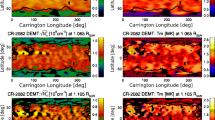Abstract
Due to their characteristic temperature and density, loop structures in active regions (ARs) can be seen bright in extreme ultraviolet (EUV) and soft X-ray images. The semiempirical determination of the three-dimensional (3D) distribution of basic physical parameters (electronic density and temperature, and magnetic field) is a key constraint for coronal heating models. In this work we develop a technique for the study of EUV bright loops based on differential emission measure (DEM) analysis and we first apply it to AR structures observed by the Atmospheric Imaging Assembly (AIA) on board the Solar Dynamics Observatory (SDO). The 3D structure and intensity of the magnetic field of the observed EUV loops are modeled using force-free field extrapolations based on magnetograms taken by the Helioseismic and Magnetic Imager (HMI) on board SDO. In this work we report the results obtained for several bright loops identified in different ARs. Our analysis indicates that the mean and width of the temperature distributions are nearly invariant along the loop lengths. For a particular loop we study its temporal evolution and find that these characteristics remain approximately constant for most of its life time. The appearance and disappearance of this loop occurs at time-scales much shorter than its life time of \(\approx 2.5\) hours. The results of this analysis are compared with numerical simulations using the zero-dimensional (0D) hydrodynamic model, Enthalpy-Based Thermal Evolution of Loops (EBTEL). We study two alternative heating scenarios: first, we apply a constant heating rate assuming loops in quasi-static equilibrium, and second, we heat the loops using impulsive events or nanoflares. We find that all the observed loops are overdense with respect to a quasi-static equilibrium solution and that the nanoflare heating better reproduces the observed densities and temperatures.









Similar content being viewed by others
References
Alissandrakis, C.E.: 1981, On the computation of constant alpha force-free magnetic field. Astron. Astrophys. 100, 197. ADS.
Aschwanden, M.J., Boerner, P.: 2011, Solar corona loop studies with the atmospheric imaging assembly. I. Cross-sectional temperature structure. Astrophys. J. 732, 81. DOI. ADS.
Aschwanden, M.J., Schrijver, C.J., Alexander, D.: 2001, Modeling of coronal EUV loops observed with TRACE. I. Hydrostatic solutions with nonuniform heating. Astrophys. J. 550, 1036. DOI. ADS.
Aschwanden, M.J., Boerner, P., Schrijver, C.J., Malanushenko, A.: 2013, Automated temperature and emission measure analysis of coronal loops and active regions observed with the atmospheric imaging assembly on the Solar Dynamics Observatory (SDO/AIA). Solar Phys. 283, 5. DOI. ADS.
Boerner, P.F., Testa, P., Warren, H., Weber, M.A., Schrijver, C.J.: 2014, Photometric and thermal cross-calibration of solar EUV instruments. Solar Phys. 289, 2377. DOI. ADS.
Bryans, P., Landi, E., Savin, D.W.: 2009, A new approach to analyzing solar coronal spectra and updated collisional ionization equilibrium calculations. II. Updated ionization rate coefficients. Astrophys. J. 691, 1540. DOI. ADS.
Cargill, P.J.: 1994, Some implications of the nanoflare concept. Astrophys. J. 422, 381. DOI. ADS.
Cheung, M.C.M., Boerner, P., Schrijver, C.J., Testa, P., Chen, F., Peter, H., Malanushenko, A.: 2015, Thermal diagnostics with the atmospheric imaging assembly on board the solar dynamics observatory: a validated method for differential emission measure inversions. Astrophys. J. 807(2), 143. DOI. ADS.
Del Zanna, G., Mason, H.E.: 2018, Solar UV and X-ray spectral diagnostics. Living Rev. Solar Phys. 15(1), 5. DOI. ADS.
Démoulin, P., Bagalá, L.G., Mandrini, C.H., Hénoux, J.C., Rovira, M.G.: 1997, Quasi-separatrix layers in solar flares. II. Observed magnetic configurations. Astron. Astrophys. 325, 305.
Green, L.M., López fuentes, M.C., Mandrini, C.H., Démoulin, P., Van Driel-Gesztelyi, L., Culhane, J.L.: 2002, The magnetic helicity budget of a cme-prolific active region. Solar Phys. 208, 43. DOI. ADS.
Hannah, I.G., Kontar, E.P.: 2012, Differential emission measures from the regularized inversion of Hinode and SDO data. Astron. Astrophys. 539, A146. DOI. ADS.
Kashyap, V., Drake, J.J.: 1998, Markov-chain Monte Carlo reconstruction of emission measure distributions: application to solar extreme-ultraviolet spectra. Astrophys. J. 503, 450. DOI. ADS.
Klimchuk, J.A.: 2015, Key aspects of coronal heating. Phil. Trans. Roy. Soc. London Ser. A 373, 20140256. DOI. ADS.
Klimchuk, J.A., Karpen, J.T., Antiochos, S.K.: 2010, Can thermal nonequilibrium explain coronal loops? Astrophys. J. 714, 1239. DOI. ADS.
Klimchuk, J.A., Patsourakos, S., Cargill, P.J.: 2008, Highly efficient modeling of dynamic coronal loops. Astrophys. J. 682, 1351. DOI. ADS.
Landi, E., Young, P.R., Dere, K.P., Del Zanna, G., Mason, H.E.: 2013, CHIANTI–an atomic database for emission lines. XIII. Soft X-ray improvements and other changes. Astrophys. J. 763, 86. DOI. ADS.
Lemen, J.R., Title, A.M., Akin, D.J., Boerner, P.F., Chou, C., Drake, J.F., Duncan, D.W., Edwards, C.G., Friedlaender, F.M., Heyman, G.F., Hurlburt, N.E., Katz, N.L., Kushner, G.D., Levay, M., Lindgren, R.W., Mathur, D.P., McFeaters, E.L., Mitchell, S., Rehse, R.A., Schrijver, C.J., Springer, L.A., Stern, R.A., Tarbell, T.D., Wuelser, J.-P., Wolfson, C.J., Yanari, C., Bookbinder, J.A., Cheimets, P.N., Caldwell, D., Deluca, E.E., Gates, R., Golub, L., Park, S., Podgorski, W.A., Bush, R.I., Scherrer, P.H., Gummin, M.A., Smith, P., Auker, G., Jerram, P., Pool, P., Soufli, R., Windt, D.L., Beardsley, S., Clapp, M., Lang, J., Waltham, N.: 2012, The atmospheric imaging assembly (AIA) on the Solar Dynamics Observatory (SDO). Solar Phys. 275(1-2), 17. DOI. ADS.
Lionello, R., Winebarger, A.R., Mok, Y., Linker, J.A., Mikić, Z.: 2013, Thermal non-equilibrium revisited: a heating model for coronal loops. Astrophys. J. 773, 134. DOI. ADS.
López Fuentes, M., Klimchuk, J.A.: 2015, Two-dimensional cellular automaton model for the evolution of active region coronal plasmas. Astrophys. J. 799(2), 128. DOI. ADS.
López Fuentes, M.C., Klimchuk, J.A., Démoulin, P.: 2006, The magnetic structure of coronal loops observed by TRACE. Astrophys. J. 639, 459. DOI. ADS.
López Fuentes, M.C., Klimchuk, J.A., Mandrini, C.H.: 2007, The temporal evolution of coronal loops observed by GOES SXI. Astrophys. J. 657, 1127. DOI. ADS.
Mandrini, C.H., Démoulin, P., van Driel-Gesztelyi, L., Schmieder, B., Cauzzi, G., Hofmann, A.: 1996, 3D magnetic reconnection at an X-ray bright point. Solar Phys. 168(1), 115. DOI. ADS.
Mandrini, C.H., Schmieder, B., Démoulin, P., Guo, Y., Cristiani, G.D.: 2014, Topological analysis of emerging bipole clusters producing violent solar events. Solar Phys. 289(6), 2041. DOI. ADS.
Nuevo, F.A., Vásquez, A.M., Landi, E., Frazin, R.: 2015, Multimodal differential emission measure in the solar corona. Astrophys. J. 811, 128. DOI. ADS.
Parker, E.N.: 1988, Nanoflares and the solar X-ray corona. Astrophys. J. 330, 474. DOI. ADS.
Pesnell, W.D., Thompson, B.J., Chamberlin, P.C.: 2012, The solar dynamics observatory (SDO). Solar Phys. 275(1-2), 3. DOI. ADS.
Reale, F.: 2014, Coronal loops: observations and modeling of confined plasma. Living Rev. Solar Phys. 11, 4. DOI. ADS.
Rosner, R., Tucker, W.H., Vaiana, G.S.: 1978, Dynamics of the quiescent solar corona. Astrophys. J. 220, 643. DOI. ADS.
Scherrer, P.H., Schou, J., Bush, R.I., Kosovichev, A.G., Bogart, R.S., Hoeksema, J.T., et al.: 2012, The Helioseismic and Magnetic Imager (HMI) investigation for the solar dynamics observatory (SDO). Solar Phys. 275, 207. DOI. ADS.
Schmelz, J.T., Christian, G.M., Chastain, R.A.: 2016, The coronal loop inventory project: expanded analysis and results. Astrophys. J. 831(2), 199. DOI. ADS.
Schmelz, J.T., Reames, D.V., von Steiger, R., Basu, S.: 2012, Composition of the solar corona, solar wind, and solar energetic particles. Astrophys. J. 755, 33. DOI. ADS.
Schmelz, J.T., Pathak, S., Christian, G.M., Dhaliwal, R.S.S., Paul, K.S.: 2015, The coronal loop inventory project. Astrophys. J. 813(1), 71. DOI. ADS.
Winebarger, A.R., Warren, H.P., Mariska, J.T.: 2003, Transition region and coronal explorer and soft X-ray telescope active region loop observations: comparisons with static solutions of the hydrodynamic equations. Astrophys. J. 587, 439. DOI. ADS.
Acknowledgements
FAN, MLF, CMacC, CHM, and AMV acknowledge financial support from the Argentine grants PICT 2016-0221 (ANPCyT) and UBACyT 20020170100611BA. AMV also acknowledges UBACyT grant 20020160100072BA that partially supported his participation in this research. FAN, MLF, CHM, and AMV are members of the Carrera del Investigador Científico of the Consejo Nacional de Investigaciones Científicas y Técnicas (CONICET). CMacC is a fellow of CONICET. The authors acknowledge the use of data from the SDO (NASA) mission. The authors thank the reviewer for his/her useful comment and suggestions that have helped to improve this article.
Author information
Authors and Affiliations
Corresponding author
Ethics declarations
Disclosure of Potential Conflicts of Interest
The authors declare that they have no conflicts of interest.
Additional information
Publisher’s Note
Springer Nature remains neutral with regard to jurisdictional claims in published maps and institutional affiliations.
Rights and permissions
About this article
Cite this article
Nuevo, F.A., Mac Cormack, C., López Fuentes, M.C. et al. Three-Dimensional Reconstruction and Thermal Modeling of Observed Loops. Sol Phys 295, 171 (2020). https://doi.org/10.1007/s11207-020-01739-4
Received:
Accepted:
Published:
DOI: https://doi.org/10.1007/s11207-020-01739-4




